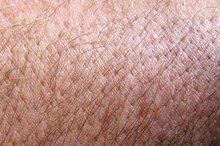What does fact checked mean?
At Healthfully, we strive to deliver objective content that is accurate and up-to-date. Our team periodically reviews articles in order to ensure content quality. The sources cited below consist of evidence from peer-reviewed journals, prominent medical organizations, academic associations, and government data.
The information contained on this site is for informational purposes only, and should not be used as a substitute for the advice of a professional health care provider. Please check with the appropriate physician regarding health questions and concerns. Although we strive to deliver accurate and up-to-date information, no guarantee to that effect is made.
Other than occasionally flitting about the house or eating holes in your favorite sweater, moths are seemingly harmless. However, moths are actually a significant cause of allergies, both indoors and outdoors. Exposure to the wing scales and other body parts of these flying insects can cause skin irritation and respiratory distress.
Wing Scales
Moths and butterflies belong to the order Lepidoptera, which is Latin for "scale-wing." Their wings are covered in a layer of powdery scales. If you've ever handled a moth, you may have noticed a powder-like residue left behind on your hands. This is because the scales are shed when the insect's wings come into contact with another object. In addition, the scales fall off as the moth flies through the air, creating an airborne allergen.
- Moths and butterflies belong to the order Lepidoptera, which is Latin for "scale-wing."
- In addition, the scales fall off as the moth flies through the air, creating an airborne allergen.
Other Sources of Allergens
Allergic Reactions From Pet Dander
Learn More
Moths may produce allergens other than their wing scales. If inhaled, the frass, or excrement, of a moth can elicit an allergic reaction. In addition, direct contact with many species of moths can cause skin irritation, due to the presence of urticating scales on the underside of the abdomen. These barbed scales can imbed into the skin, causing severe inflammation and itching. If inhaled, urticating scales can cause asthma and respiratory irritation.
- Moths may produce allergens other than their wing scales.
- If inhaled, urticating scales can cause asthma and respiratory irritation.
People Affected
The people most at risk of developing an allergy to moths are entomologists and workers in facilities that raise moths as beneficial insects 1. These people work in facilities where the air may be filled with moth scales. Bakers frequently develop moth allergies, as the scales of the flour moth are a contaminant often found in flour and cereals. A study published in the January 1994 issue of "Annals of Allergy" suggests that people with asthma and other allergies are especially sensitive to moths.
- The people most at risk of developing an allergy to moths are entomologists and workers in facilities that raise moths as beneficial insects 1.
- Bakers frequently develop moth allergies, as the scales of the flour moth are a contaminant often found in flour and cereals.
Dealing with Moth Allergies
Allergic Reactions to Mustard and Ketchup
Learn More
For those affected by moth allergies, the best course of action is to limit exposure to the insects. Many insect-rearing facilities have safety measures in place to limit workers' exposure to airborne allergens 1. Household moths can be controlled by storing clothes properly, or through the application of a pesticide. Serious moth infestations should be treated by a professional exterminator. Sensitive individuals should consult a physician to determine measures necessary to treat an allergic reaction to moths.
- For those affected by moth allergies, the best course of action is to limit exposure to the insects.
- Many insect-rearing facilities have safety measures in place to limit workers' exposure to airborne allergens 1.
Related Articles
References
- Centers for Disease Control and Prevention: Work-Related Allergies in Insect-Raising Facilities
- "Food Insects News Letter"; Allergies Related to Food Insect Production and Consumption; Philips, J. and Burkholder, W.; Vol. 8, No. 2.; 1995
- "Entomology Circular"; Urticating Caterpillars in Florida; Heppner, J.B.; January 1994
- "EntFact #609"; Clothes Moths; Potter, Mike; 2010
- Young SG, Jones IF, Claypool HM. Stimulus Threat and Exposure Context Modulate the Effect of Mere Exposure on Approach Behaviors. Front Psychol. 2016;7:1881. Published 2016 Nov 29. doi:10.3389/fpsyg.2016.01881
Writer Bio
Jeremy Nicholson has been writing since 2009, specializing in human anatomy and physiology, pathophysiology, biology and tarantula care. Nicholson holds a Bachelor of Science in zoology, a Bachelor of Arts in English and a Master of Science in biology, all from Texas Tech University.








